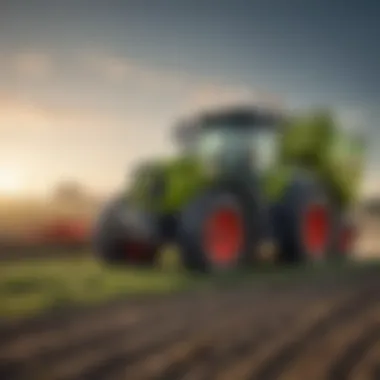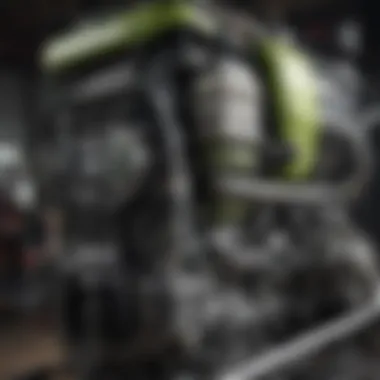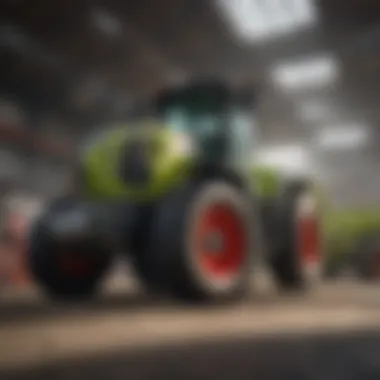Comprehensive Guide to Used Claas Tractors for Sale


Intro
In the agricultural sector, the purchase of used machinery is a significant decision for many farmers and agricultural enthusiasts. Among the various brands, Claas stands out for its reputation for quality and durability. Understanding the marketplace for used Claas tractors is essential for making informed choices.
This guide seeks to explore the intricacies involved in buying used Claas tractors. From determining your needs to evaluating specific models, each step is vital. It focuses on key considerations and practical advice to enhance the buying experience, helping readers navigate potential pitfalls and ensuring they make sound investments.
Maintaining machinery is equally important, and this guide will touch on maintenance practices that can extend the life of these tractors. Additionally, we will discuss financing options to ease the burden of hefty upfront costs.
As the agricultural industry evolves, staying informed about market trends and the condition of equipment is crucial. This guide aims to provide a comprehensive understanding of these elements, tailored specifically for the needs of farmers and professionals in the agriculture field.
Research and Data Analysis
Recent Trends in Agriculture
In examining the market for used Claas tractors, understanding recent trends is essential. The agricultural landscape has shifted towards automation and efficiency, prompting farmers to seek tractors that integrate modern technology without compromising the traditional robustness that Claas offers. Many buyers show increased interest in models equipped with precision farming capabilities. These features enhance productivity by utilizing data for smarter decision-making in farming practices.
Statistical Insights into Crop Yields
Statistics reveal that the selection of appropriate equipment significantly impacts crop yields. Research indicates that farmers using high-quality machinery, like Claas tractors, tend to experience a 10-30% increase in crop productivity compared to those who utilize older, less efficient models. This relationship between machinery quality and agricultural output highlights the importance of investing in reliable equipment.
Best Practices and Techniques
Efficient Crop Management Strategies
When considering used Claas tractors, it is important to think about how they can fit into broader crop management strategies. Efficient management can increase profitability and sustainability. A blend of technology-driven practices such as crop rotation, and supplemented fertilization methods, supported by a reliable tractor can drastically improve yield.
Sustainable Horticultural Techniques
Investing in sustainable horticultural techniques alongside quality machinery is essential. Tractors that support these practices help in the growth of environmentally friendly operations. Brands like Claas are known to offer models that cater to sustainability through reduced emissions and improved fuel efficiency, which are becoming increasingly relevant in modern farming.
Pest and Disease Management
Common Pests and Diseases in Crops
Farmers also have to deal with the realities of pests and diseases. The effectiveness of any agricultural operation is often influenced by how these issues are managed. Knowing how to use your Claas tractor effectively in pest control, such as through timely applications of pesticides, is crucial.
Integrated Pest Management Strategies
Implementing integrated pest management strategies allows for maintaining healthy crop growth while minimizing chemical usage. This approach can be effectively supported by the capabilities of Claas tractors, allowing for precise action in managing pest populations.
The choice of machinery is just as important as the techniques used in agriculture; both must align for optimal results.
Overall, this guide sets the stage for understanding not only the key aspects of the used Claas tractors market but also highlights the interconnectedness of various agricultural practices, which ultimately lead to successful farming operations.
Foreword to Used Claas Tractors
The agricultural sector continually evolves, and the machinery used in farming plays a critical role in this transformation. Among prominent brands, Claas tractors stand out due to their advanced technology and reliable performance. Understanding this machinery is essential for farmers looking to enhance productivity and efficiency on their farms.
Used Claas tractors offer significant value for those who cannot invest in new machinery. They provide the same reliability but at a reduced cost, making them attractive options. The importance of buying used equipment is underscored by the economic benefits they offer to small and large-scale farmers alike.
Overview of Claas Tractors
Claas manufactures a broad range of agricultural machinery, including tractors, combines, and forage harvesters. Founded in 1913, Claas has built a reputation for innovation. Their tractors, known for their robust construction and efficient engines, cater to a variety of farming needs. From small plots to large fields, Claas tractors deliver high performance. They incorporate user-friendly technology, which simplifies operations. The versatility of these machines is especially beneficial for modern farming, where adaptability is crucial.
Purpose of This Guide
This guide aims to provide a thorough understanding of used Claas tractors for potential buyers. It will explore critical considerations before making a purchase. Rather than approaching this topic superficially, the guide delves deeply into factors such as cost-effectiveness, maintenance, market availability, and financing options. Such detailed exploration helps buyers make informed decisions, ensuring that they choose machinery that aligns with their needs.
Ultimately, the goal is to assist farmers and agricultural enthusiasts in navigating the complexities of the used tractor market. Identifying quality used machinery can lead to significant operational improvements and cost savings, crucial for sustainability in agriculture.
Why Choose Used Claas Tractors?
When considering the acquisition of a tractor, the brand and model can significantly influence the decision-making process. Claas has established itself as a reputable name in the agricultural machinery industry, known for its innovative features and durability. This section aims to elucidate why choosing used Claas tractors can be a sound investment for farmers and agricultural enthusiasts. Below, we will discuss three main reasons: cost-effectiveness, performance and reliability, and wide availability.
Cost-effectiveness
Purchasing used Claas tractors presents an opportunity for buyers to save significant sums compared to buying new equipment. The depreciation on agricultural machinery is steep, often making new models lose a substantial percentage of their value shortly after purchase. By opting for used, buyers can benefit from the previously incurred depreciation, obtaining a well-maintained unit at a reduced price.


Additionally, lower upfront costs mean that farmers can allocate resources toward other essential areas, such as seed, fertilizer, or labor. Furthermore, banks and financing institutions often offer favorable terms for used equipment, making financing more accessible for the farmers.
In summary, cost savings on initial investment, combined with smart financing options, makes used Claas tractors a prudent choice for those looking to enhance their farming operations on a budget.
Performance and Reliability
Claas tractors are engineered for high performance and reliability. Their robust design ensures that they can endure the rigors of agricultural work day in and day out. Used Claas tractors, particularly those with comprehensive service histories, often prove that they can maintain reliable operations over time. This durability is largely attributed to the advanced technology and engineering that Claas employs in their manufacturing process.
Farmers engage in demanding tasks that require machinery that does not only perform well but withstands tough conditions. Many used Claas models feature powerful engines that deliver optimal performance even when under heavy loads. When buying a used Claas tractor, potential owners should examine the hours of use and maintenance records to gauge the vehicle's reliability.
Wide Availability
Another reason to consider used Claas tractors is their wide availability in the market. Given that Claas has a strong presence in the agricultural sector, various dealerships, online marketplaces, and auction houses often have a selection of used tractors. This broad availability allows buyers to compare features, prices, and conditions, facilitating informed decisions.
Farmers can find a tractor that fits their specific needs and budget without feeling rushed in their selection. Additionally, the range of models available means buyers are likely to discover something that aligns perfectly with their operational requirements. Whether it’s a smaller model for a family farm or a larger unit for expansive agricultural land, options are plentiful.
"Choosing a used Claas tractor can provide immediate savings without sacrificing quality or performance."
Evaluating the Condition of Used Tractors
Evaluating the condition of used tractors is a critical step in the buying process. Knowing how to properly assess this condition allows potential buyers to make informed decisions. This process helps avoid costly repairs down the line and ensures that the tractor will meet the specific needs of the buyer. There are three major aspects to consider: visual inspection, functional tests, and documentation check. Each of these areas uncovers different details that affect the tractor's longevity and performance.
Visual Inspection
Body Condition
The body condition of a used tractor is the first indicator of its overall health. Buyers should look for any signs of wear and tear on the exterior. Scratches, dents, or extensive repainting can suggest past issues. A well-maintained body often means the tractor has been taken care of properly. It plays a vital role in preserving the tractor's value over the years. Buyers should pay special attention to this aspect, as it indicates how the previous owner treated the machine.
Tyre Wear
Tyre wear is another important visual aspect. Uneven wear on tyres can signal issues with alignment or weight distribution. Inspecting the tyres for bulges or cracks is essential as this can affect the tractor's mobility and safety. Good-quality tyres can significantly enhance traction and efficiency. Hence, assessing tyre condition gives insight into the tractor's handling and ongoing performance.
Rust and Damage
Rust and damage can severely impact a tractor's functionality. It weakens structural components and can lead to further deterioration if not addressed. Checking for rust in critical areas like the chassis and undercarriage is crucial. This aspect can reveal how the tractor has been stored and used over time. Buyers should be cautious of any significant rust patches, as they can indicate deeper problems that may require costly repairs.
Functional Tests
Engine Performance
Understanding engine performance is vital before purchases. A well-performing engine usually translates to reliability in the field. Buyers should test the engine by starting it and listening for unusual sounds. Smoke or vibrations can indicate underlying issues. A proper inspection will uncover how well the engine has been maintained.
Transmission and Hydraulics
The transmission and hydraulics are essential for a tractor's operational capabilities. They ensure that power is efficiently transferred to the wheels and implements. Buyers should test these systems during a trial run. Shifting gears smoothly and responsive hydraulics are signs of a healthy tractor. Issues in this area can lead to poor performance and increased repair costs.
Electrical Systems
Electrical systems also play a major role in a tractor's operation. Functioning lights, indicators, and connections are crucial for safety and usability. Buyers should check the battery condition and wiring for any deterioration. Faulty electrical systems can lead to operational failures that may not be easily visible during a visual inspection.
Documentation Check
Maintenance Records
Examining maintenance records can provide insights into how the tractor has been cared for. Regular maintenance may indicate reliability and attention to detail by the previous owner. Buyers should request service records and check for routine oil changes, filter replacements, and inspections. Well-documented maintenance is often a good sign of a tractor in decent shape.
Previous Ownership
Learning about the previous ownership can help gauge the tractor's history. Knowing how many prior owners there were, or if the tractor was used for heavy-duty tasks, can influence its value. A single owner who maintained their equipment carefully is often preferable. This information can further inform the buyer's decisions about the trustworthiness of the machine.
Operating Manuals
Operating manuals are useful resources that should not be overlooked. They offer guidance on maintenance procedures and troubleshooting common issues. Ensuring that the tractor comes with these manuals can save time and effort for the new owner. Manuals often also include essential safety guidelines, which should always be prioritized.
Market Insights for Used Claas Tractors
Understanding the market for used Claas tractors is crucial for anyone looking to make a sound investment. With the agricultural sector evolving rapidly, it is essential to be aware of current trends and available resources. This knowledge helps potential buyers gauge market temperatures—such as demand, pricing, and availability—of these machines. Moreover, being informed not only aids in making educated purchasing decisions but also ensures that the investment made aligns with both immediate needs and long-term goals in farming operations.


Current Trends in the Market
The market for used Claas tractors reflects various trends that are indicative of the broader agricultural landscape. Currently, several factors influence buyer behavior:
- Sustainability Focus: Many farmers prioritize machinery that supports sustainable practices. Claas tractors often feature fuel-efficient engines, which appeal to environmentally conscious buyers.
- Technological Advancements: New technology in farming equipment drives interest. Buyers look for tractors with integrated technology, even in the used market, ensuring they can leverage modern advancements in efficiency.
- Market Fluctuations: Economic conditions can affect pricing. Understanding regional economic trends helps buyers time their purchases when market conditions are favorable.
Being aware of these trends enhances the buyer's position and opens up opportunities for better deals.
Where to Find Used Claas Tractors
Finding used Claas tractors requires utilizing various channels. Each source has unique attributes that make it appealing for different types of buyers. Here are some of the main avenues:
Dealerships
Visiting authorized Claas dealerships can be highly advantageous. These establishments often provide a range of used tractors that are certified for quality. A key characteristic is that these dealerships have undergone rigorous inspections. This ensures that buyers receive reliable machinery.
Dealerships often maintain long-term relationships with customers, fostering trust. They provide warranties on used equipment, which is a significant benefit. However, prices at dealerships may be higher compared to private sales due to the additional services they offer.
Online Marketplaces
Online marketplaces such as eBay or Craigslist present a vast selection of used Claas tractors. The key characteristic here is accessibility. Buyers can compare numerous options quickly and from the comfort of their homes.
Online platforms can also lead to competitive pricing, as sellers may be looking to offload their equipment quickly. However, buyers must exercise caution as the lack of physical inspection may lead to unexpected issues. Verifying seller credibility is crucial in these cases.
Auctions
Auctions represent another avenue for purchasing used Claas tractors. They offer a unique dynamic where buyers can engage in live bidding. A key characteristic of auctions is the potential for significant savings. Often, tractors can be acquired at lower prices due to bidding competition among buyers.
However, auctions come with risks. Detailed inspections are often not possible before bidding. Buyers must be prepared to act quickly and know the worth of what they are bidding on. Understanding auction terms and conditions thoroughly is also important to avoid any misunderstandings.
Financing Options for Purchasing Used Tractors
Financing options play a crucial role when considering the purchase of used Claas tractors. Given the significant investment required, understanding the available financial avenues can influence decision-making. The right financing option can provide flexibility, make budgeting easier, and ultimately lead to a more favorable purchase experience. This section will delve into specific financing strategies that potential buyers should consider, including traditional financing methods, leasing versus buying decisions, and the impact of government grants and subsidies.
Traditional Financing
Traditional financing is a common method for acquiring used tractors. This approach typically involves securing a loan from a bank or a credit union. The buyer repays the loan amount, plus interest, over a predetermined period. Several advantages accompany traditional financing:
- Lower interest rates: Banks may offer competitive interest rates, especially for borrowers with strong credit histories.
- Ownership: After repayment of the loan, the buyer fully owns the tractor.
- Repayment terms: Buyers can often choose between various repayment terms, tailoring the plan to their financial situation.
However, potential buyers should also consider possible downsides. For instance, the initial down payment can be substantial and may affect cash flow. Additionally, securing a loan may require a good credit score and financial documentation.
Leasing vs. Buying
Another option is leasing. Leasing is different from buying as it allows the user to utilize the tractor for a defined period. At the end of the lease, the buyer typically has the option to purchase the tractor or return it. Here are some key points to weigh:
- Lower monthly payments: Leasing often results in lower monthly payments compared to traditional financing.
- Maintenance inclusions: Many leases include maintenance packages, reducing the overall cost of upkeep.
- Flexibility: Leasing allows farmers to use new models more frequently, adapting to changing agricultural needs.
On the other hand, while leasing provides short-term financial relief, it does not lead to ownership. Buyers must assess their long-term needs to make an informed choice between leasing and purchasing outright.
Government Grants and Subsidies
Government grants and subsidies can significantly alleviate the burden of purchasing used tractors. Such financial programs aim to support farmers and could reduce the overall investment required. However, understanding eligibility and application processes is crucial. Here are some benefits of leveraging these financial incentives:
- Reduced upfront costs: Grants can cover a portion of the purchase price, making higher-quality equipment more accessible.
- Investment in sustainability: Many grants focus on environmentally friendly practices, incentivizing efficient agriculture.
- Region-specific programs: Different areas may have tailored programs, so researching local resources is essential.
Buyers should always check for local and federal programs that support agricultural investments.
Maintenance of Used Claas Tractors
Maintaining used Claas tractors is vital for ensuring their longevity, operational efficiency, and safety. Proper maintenance not only enhances performance but also prevents costly repairs and downtime. Farmers and agricultural professionals need to understand the best practices for maintaining used equipment, specifically focusing on routine maintenance and common repairs.
Routine Maintenance
Routine maintenance is the foundation for keeping Claas tractors in optimal condition. It involves regular checks and services that help identify and prevent potential issues.
Fluid Checks


Fluid checks include monitoring engine oil, hydraulic fluid, and coolant levels. These fluids are essential for smooth operation. Regularly checking and replacing them can notably improve the tractor's efficiency. A significant aspect of fluid checks is that they prevent engine wear and overheating. Therefore, farmers find this process beneficial for long-term use.
Key reason for giving attention to fluid checks includes:
- Preventive measure: Detects issues before they escalate.
- Easy to perform: Can be done frequently with basic tools.
One unique feature of fluid checks is that they can often indicate the overall health of the tractor. However, if ignored, low fluid levels can lead to severe damage.
Filter Changes
Filter changes are crucial for maintaining cleanliness in the hydraulic system and engine. Air, oil, and fuel filters must be changed regularly to ensure contaminants do not cause problems. The primary benefit of changing filters is improved performance and reduced risk of breakage. This makes it a popular choice for maintaining used Claas tractors.
- Reduces risk: Keeps contaminants from affecting engine and components.
- Improves efficiency: Allows for better fuel consumption.
One downside is that it may require more frequent service visits, but the long-term benefits outweigh these inconveniences.
Tire Inflation
Tire inflation is another key aspect of routine maintenance. Properly inflated tires ensure better traction and fuel efficiency. Additionally, they help in preventing uneven wear, which can lead to costly replacements. Tire inflation is a fundamental task that can readily be performed by operators.
Key points regarding tire inflation include:
- Safety: Ensures stability during operation.
- Efficient fuel usage: Reduces drag, promoting better performance.
The disadvantage of incorrect tire inflation is that it can lead to accidents or performance degradation.
Common Repairs
All tractors will eventually need repairs, and recognizing common issues can save time and money for users.
Engine Issues
Engine issues are perhaps the most common breakdown reason for used tractors. These can stem from neglect of routine maintenance or operational mishaps. Addressing engine problems promptly is vital as they can affect the entire functionality of the tractor.
The characteristic of engine issues is that they often require timely intervention.
- Critical for operation: Without a functional engine, the tractor is useless.
- Can be costly: Major repairs can lead to significant expenses if not handled quickly.
One of the unique aspects of engine issues is their varied nature, ranging from minor leaks to complete failures.
Transmission Failures
Transmission failures can disrupt operations entirely. Common reasons include wear and tear, improper gear shifts, or neglected maintenance. Ensuring the transmission system is well-maintained helps in avoiding extensive repairs.
- Helps with efficiency: Prevents unnecessary delays and improves performance.
- Critical attention needed: Requires regular checks and maintenance.
While repairs can be done, they can lead to prolonged downtimes, affecting productivity.
Hydraulic Problems
Hydraulic problems are also frequently seen in used tractors. These issues often arise from leaks, wear, or lack of lubrication. Addressing hydraulic issues promptly can prevent extensive damage to the tractor's operation.
Unique features of hydraulic problems include:
- Complex systems: The hydraulic system requires thorough understanding for repairs.
- Importance in functionality: Affects many tractor functions, such as lifting and steering.
Neglecting hydraulic problems can lead to failures in critical components, causing significant operational delays.
Epilogue and Recommendations
The conclusion of this guide serves as an important summation of the insights and advice provided throughout. In the realm of used Claas tractors, making informed decisions is critical for optimizing agricultural operations. It is essential to take into consideration not just immediate costs, but also the long-term benefits associated with quality machinery. Purchasing a used Claas tractor can lead to significant financial savings, while also ensuring reliability and performance. Thus, understanding what to look for in terms of evaluation, maintenance, and market trends can greatly enhance the purchasing experience.
Final Thoughts
This guide has laid out the key factors that one must consider when investing in a used Claas tractor. The brand's reputation for durability and efficiency makes Claas a strong contender in agricultural machinery. Moreover, the availability of various models means buyers can select one fitting their specific needs and budget. Attention to condition, market data, and financing options will empower you to make a sound investment. Make sure to factor in the requirements of your farm's operations to ensure that any purchase directly supports productivity and effectiveness.
Next Steps for Buyers
Once you are ready to begin your search for a used Claas tractor, there are several steps you should follow to facilitate the process:
- Research: Gather knowledge on available models and their specifications.
- Set a Budget: Determine how much you can spend, considering financing options if necessary.
- Inspect Potential Purchases: Conduct thorough visual inspections and functional tests of tractors of interest.
- Review Documentation: Ensure that all maintenance records and ownership details are in order.
- Negotiate: Don't hesitate to negotiate the price based on your findings.
- Final Purchase: Once satisfied with your choice, proceed with the acquisition and prepare for future maintenance.
Engaging with local dealers, online platforms, or auctions can yield fruitful results in finding the right Claas tractor. Always maintain a professional skepticism; this will serve you well in making the right purchase for your agricultural needs.















